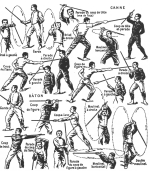|
Last Page Update:
October 16, 2001
Contact
Copyright Information
Main Page
Structure of the Red Kaganate
Gatherings, Events, . . .
Historic Steppes Tribes
Legends of the Nomads
Flags and other Identifiers
Clothing and Apearance
Food and related Matters
Armour
Archery
Weapons and Combat
Public Forum
Resource Links
Email:
[email protected]
Editor:
Norman J. Finkelshteyn
|
Chambering in Canne du Combat as potential safety standard for so-called �early period� weapons sparring.
By Russ Mitchell
|
DISCLAIMER: This is a brief overview that assumes a set of skills on the part of the reader. A cane is an inherently dangerous instrument. The practice of stick fighting requires discipline, training, and protective equipment. This page is presented solely for the academic interest of the subject matter.
|
The sport of la canne, or, more specifically canne du combat (as opposed to canne d�arme, which is strictly non-ludic), uses an interesting safety standard. Since a full-weight cane will easily cripple a man within a few blows, and the protective gear of the day was not (and still is not) up to the task of defending a canne-ist from the effects of such a weapon while preserving the inherent mobility of the style, the french hit upon the solution of using a lightweight cane (similar to a 1/2" dowel).
However, being particularly clever, they also realized that using a lightweight cane would also result in lots of flicking attacks, none of which are able to generate the appropriate amount of power when one�s practice weapon was then translated back to a heavy walking cane. The French stumbled onto a truly elegant solution: all swings with the lightweight cane require a �full chamber,� as we might say, such that one must move the weapon through the kind of arc required to move the heavy cane, even though it�s actually a light one.
As a sport, it�s magnificent. What happens is that, rather than having both canne-ists stuck in middle guards, or playing the pure-speed flicking game into which modern sabre fencing has disintegrated, it's timing that really comes to the fore. For example, a classical technique would be to throw a horizontal blow that hits one�s opponent on the back of the shoulder blade (or neck, back of the head, kidney, etc) while said opponent is trying to smack you in the middle of the head. If you think that this is no mean feat, you�re right. But it�s also the average level at which the game is played.
For adjustment to lightweight sparring weapons, the canne standard should work well. Lightweight sword, mace, and axe simulators, having different weights and balances, will all handle differently. For example, a man playing at a Viking style with a long-handled Danish Axe simulator will find that he makes more circular arcs with his weapon than his fellow using a shorter and more evenly balanced broadsword. Maces are, well, dramatically effective simply adapting straight techniques from la canne.
So, how does it work? See the collage image for an idea. The rule of chambering, is that between each and every strike, the hand must be brought back behind the line of the shoulder blades. So if I�m going to throw a right-to-left horizontal neck cut with a �sword,� followed by a left-to-right, assuming that I stand still, my hand will actually go back behind my head. This does not mean that said arc needs to be perfectly circular: it�s perfectly possible to make a variety of very tight arcs. Now, experimentation will be required to do this while holding bucklers and shields... but that should wind up being half the fun.
For images of the cane method used by Charlemont (one of the giants of savate), see this url: http://ejmas.com/jnc/jncart_Charlemont_1200.htm. This is a very limited selection, and unfortunately does nothing to demonstrate the dynamism of the sport, but it does show some elementary baton work, which should be useful for people who want to use two-handed weapons.
|


